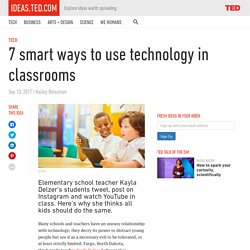

How To Use VR/AR Technology In Your Classroom In 2018 — ProjectEd. 27 Meaningful (and Fun) Ways to Use Technology for Teaching and Learning. A Cavalcade of Inspiring Ideas for Kicking up Learning and Enhancing Engagement in Your Classroom! There are enough ideas, resources, and (mostly) free tools here to keep you exploring and learning all year long. Have at it! 1. Get Your Students Creating There is just no limit to the way that students can use the endless free resources available on the Web to create! 2. If there are devices at your student's disposal, using them to let students provide real time feedback has never been easier. 3. Collaboration is a vital 21st century skill, and collaborating via the web with your students can be free and easy!
4. 2015 was an awesome year for Augmented Reality tools for the classroom. 5. We've all heard the buzz about “gamification”. 6. The Maker Movement and Maker Spaces got a lot of attention over the last year, and deservedly so … when students create, they learn! 7. 8. One of the funnest ways to use collaborative tools in the classroom is to create with them! 9. 10. 11. 12. 13. 14. 6 Ed Tech Tools to Try in 2018. Ideas For Using Technology In The Classroom. Over recent years, types of technology in the classroom have vastly improved.

Increasing numbers of schools are turning away from traditional whiteboards, projectors, and textbooks and embracing interactive displays, and laptops and tablets instead. For educator’s technology is a fantastic way to modernise teaching strategies and offer the best possible learning experience to students. In this article we’re going to take a look at the many ways to integrate technology in the classroom. There are many benefits of using technology in the classroom, with the biggest being higher rates of student engagement. Technology can allow for more interaction because it offers more versatile teaching and learning methods than the traditional lecture environment. Flexible resources With interactive classroom displays, teachers can showcase various different types of media – from simple text documents to videos, games, and apps – and annotate directly on the board as they go.
Heightened skills. 7 smart ways to use technology in classrooms. Istock Elementary school teacher Kayla Delzer’s students tweet, post on Instagram and watch YouTube in class.

Here’s why she thinks all kids should do the same. Many schools and teachers have an uneasy relationship with technology: they decry its power to distract young people but see it as a necessary evil to be tolerated, or at least strictly limited. Fargo, North Dakota, third-grade teacher Kayla Delzer believes that technology can truly revolutionize education — but only if educators make wise choices about what is used and how it’s used (TEDxFargo Talk: Reimagining Classroom Teachers as Learners and Students as Leaders). It’s way too late to try to keep tech out of classrooms — or children’s lives.
Tech tip #1: Something boring on paper is still boring on a tablet or a laptop. “Using technology simply for the sake of using it is wasteful,” Delzer says. One way that Delzer’s students learn math is by playing an augmented-reality geometry board game called Cyberchase Shape Quest. Five Ways Teachers Can Use Technology to Help Students. Thomas Edison once said, “Books will soon be obsolete in the public schools…our school system will be completely changed inside of ten years.” Amazingly enough, however, one of our nation’s most important inventors was proven quite wrong.
The American education system has a remarkable resistance to innovation and the classroom experience has changed very little in the 100 years since Edison’s prediction. 12 Easy Ways to Use Technology in the Classroom, Even for Technophobic Teachers. Everyone wants teachers to use technology in the classroom. But you're busy -- meeting standards, prepping students for tests -- and maybe you’re not too fond of computers, anyway. 10 of the Most Engaging Uses of Instructional Technology. Are you looking for ways to integration technology in your lesson plans and courses that provide for an engaging experience for you and your students? Fans of instructional technology know that it can be fun and inviting, and engaged students are far more likely to be learning. I believe that if you can get students involved and motivated effectively enough, you can improve their learning habits over the long term.
With that in mind, here are 10 highly engaging uses of technology in the classroom, along with dozens of tools and resources for implementation. Most of these involve free web based tools, so that's an added bonus! Interactive Collaboration The 2014 Gates Foundation report, Teachers Know Best: What Educators Want from Digital Instructional Tools, indicates that teachers want tools “supporting student collaboration and providing interactive experiences”.
Teaching with Technology. Teaching Section 2: Teaching with Technology Goal: Educators will be supported by technology that connects them to people, data, content, resources, expertise, and learning experiences that can empower and inspire them to provide more effective teaching for all learners. Technology offers the opportunity for teachers to become more collaborative and extend learning beyond the classroom. Educators can create learning communities composed of students; fellow educators in schools, museums, libraries, and after-school programs; experts in various disciplines around the world; members of community organizations; and families. This enhanced collaboration, enabled by technology offers access to instructional materials as well as the resources and tools to create, manage, and assess their quality and usefulness. 25 Easy Ways to Use Technology in the Classroom.
Although many technology-based teaching methods and resources effectively engage students and build their skills, many educators encounter difficulties when using technology in the classroom. Maybe a specific platform is too hard to introduce. Or maybe it won’t run on your devices. Despite the challenges, you likely want to enjoy the benefits that education technology can deliver.